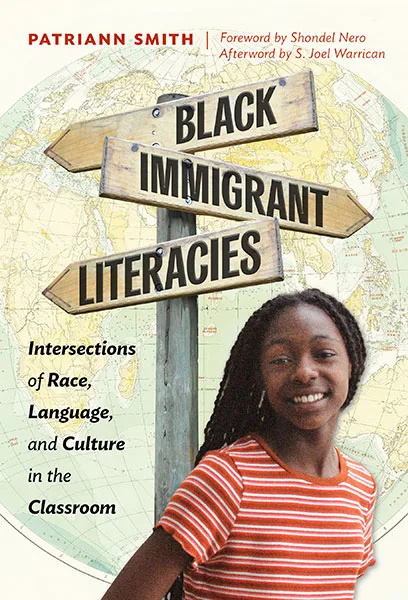 Patriann Smith is an associate professor in literacy studies at the University of South Florida and coauthor of Affirming Black Students’ Lives and Literacies: Bearing Witness. She is the author of Black Immigrant Literacies: Intersections of Race, Language, and Culture in the Classroom.
Patriann Smith is an associate professor in literacy studies at the University of South Florida and coauthor of Affirming Black Students’ Lives and Literacies: Bearing Witness. She is the author of Black Immigrant Literacies: Intersections of Race, Language, and Culture in the Classroom.
A few years ago, I wrote a blog entitled Why Eurocentric literacy measures may be creating the illusion that Black students are underperforming for the London Society of Economics United States American Politics and Policy Blog (LSE USAPP). Later, in an article for the Journal of Black Studies based on the blog, Rethinking ‘underperformance’ for Black English speakers: Beyond achievement to opportunity, I challenged the notion of what is often touted as a pervasive literacy “achievement gap,” which is based primarily on comparisons between Black and White students. Alluding to the opportunity gap explanatory framework proposed by Richard Milner, I showed that the argument that this gap exists tends to overlook data based on comparisons among Black youth, specifically as reflected by the international assessment, the Program for International Student Assessment (PISA) reading literacy.
I argued that these comparisons, which have repeatedly tended to emphasize Black immigrants as a “model minority” and as more “successful” in literacy as compared to their African American counterparts, fail to acknowledge that Black immigrant students themselves perform below the average set by the Organization for Economic Development (OECD). This is true across multiple iterations of the examination across time. Additionally, the evidence points to serious challenges in how English has been measured as a predictor of reading literacy. Specifically, it suggests that a significant number of Black youth—both immigrant and African American—who claimed to be English speakers were users of Englishes whose linguistic repertoires could not be captured by the PISA reading literacy assessment, which is based on Eurocentric norms.
Based on this evidence, I reiterated the need to address the lack of opportunity allowed for students to reflect their literacies when literacy is assessed on Eurocentrically-based and driven measures such as PISA, which is mirrored in large part by national literacy assessments globally, across countries. In turn, I emphasized the importance of dismantling model minority myths that position Black immigrants in opposition to their African American and other immigrant peers.
As I examined this issue further, I saw more clearly the raciolinguistic tenets in which the conundrum was steeped. In Five Steps to Address Anti-Blackness: Black Immigrant Literacies, a blog for ILA, and Beyond Anti-Blackness in Bilingual Education, a piece for the American Educational Research Association’s Bilingual Education Research Special Interest Group, I considered how anti-Blackness has formed the basis for the pervasive silence regarding Black students across bilingual programs, as well as the limited emphasis placed on the bilingualism of Black students at large.
Though anti-Blackness is not new, as a resident of Florida—ground zero for myriad “anti-woke” yet unenforceable pieces of legislation such as the “Stop WOKE Act”—it is clear that we are in a unique moment in which concepts such as Critical Race Theory (CRT) are being challenged and books that reflect the accurate histories of Black people are being banned, and that this is happening across the United States. At the same time, immigrants to this country—including Black immigrants—continue to face tremendous resistance, and even repulsion and disgust.
This blatantly hostile response to Black personhood, and to the personhoods of Indigenous people and other people of color, has been further exacerbated by the recent wave of racial reckoning. This racial reckoning has occurred seemingly in response to an emboldened languaging and semiotics of hate, made most visible in the murder of George Floyd and the violent uprising against the United States government on January 6. In turn, the accompanying (and often polarizing) narratives in the media continue to send a strong message to students who are Black, immigrant, people of color, Indigenous, LGBTQ, or who language and semiotize in ways that are positioned on the periphery of schools: that they do not belong.
The fact that this feeling of not belonging is perpetuated by those trusted with governing this country and its currently divided states tugs at the strings of our hearts—hearts that wish to beat across the binary of Black and White—and many of which long for raciolinguistic redemption. This transdisciplinary beckoning inspired my book, Black Immigrant Literacies: Intersections of Race, Language, and Culture in the Classroom, and amid it lies the promise that we can disrupt the continued, colonially-imposed dichotomies that are persistently perpetuated in language and literacy research. Through the lens of the Black immigrant’s literate practice, we are invited to wrestle with a decades-long contention in literacy research that positions “academic literacy” against “home literacy,” and to invoke a silencing of the all too boisterous notes of power that operate based on racialization in the way we teach (through) language in mainstream, bilingual, and multilingual K–12 and college classrooms.
In the transdisciplinary beckoning which formed the basis for my engagement with Black immigrant literacies—a beckoning that continues to invoke novel imaginaries—I ask us to imagine an engagement with race and language, across, and beyond it (i.e., transraciolinguistics), by articulating a provocation of the mind that would dare us to envision how our K–12 and college/university classrooms might use the five elements of the Black immigrant literacies framework—laying claim to the struggle for justice, disrupting the myth of the model minority, a transraciolinguistic approach, connecting the local to the global, holistic literacies—to restore our capacity and the capacity of all students to be human.
The prism of Black immigrant literacies can create spaces within classrooms for extending meaning-making through students’ literacies while building avenues for solidarity, which provides literacy and language teachers and instructors insight into the students’ continued progress. Specifically, the element of holistic literacies presented in the framework, which I choose to highlight here, uses the lens of the Black immigrant in the United States to demonstrate how literacies can be re(purposed) as holistic (as opposed to fragmented and dichotomous, based largely on a privileging of literacy performance as reflected by tests). Through holistic literacies, youth use language, multiliteracies, and cross-border shifts to act as language architects who reread and rewrite text that includes Englishes and semiotic resources from their life worlds across home and school, through languaging that is based on an understanding of racialized tensions. The semiotic resources undergirding meaning-making in literacy, as Black immigrant youth literacies show, position all students in ways where the modalities that they use are racialized even as these are entangled with their personhoods: “raciosemiotic architecture.”
Considering how racialization impacts the multiple modalities that students of color leverage, this dynamic extends the notion of “language architecture” as proposed by Nelson Flores to illustrate how semiotics and multimodality are mediated by power relations, many of which are premised on the racialized structures that are encoded in what it means to make meaning with texts that are often non-linguistic in nature. Students acting as raciosemiotic architects manipulate multiple modalities for specific purposes while engaging racialization based on how they understand choice and meaning to be related via their socialization into cultural, linguistic, and racial community practices—thus, “raciosemiotic architecture.”
Through raciosemiotic architecture, there are opportunities for engaging students’ multiple modes of meaning-making across home and school—sans dichotomy—for particular purposes while centering the often-invisible racialization of these modes across cultural, linguistic, and racial communities. Through raciosemiotic architecture, the prism of Black immigrant literacies offers a “both-and” approach as a potential pathway for addressing the long-standing impasse, with its accompanying dichotomies and debates, surrounding literacy and education of Black peoples. That is, students’ racialization and the racialization of their languaging and semiotics can be acknowledged as they exercise their capacity to leverage their rich multilingual and multimodal resources for meaning-making seamlessly across home and school, but this racialization can also be acknowledged as they navigate the pervasive Eurocentric norms undergirding language and semiotics that they continue to face in schools.
As seen in the recent immigrant-inspired, quantum-invoked film, Everything Everywhere All at Once, our response does not need to be an “either-or” approach as we learn from transdisciplinarity and the quantum notion of multiple levels of reality. It can be “both-and”: an approach that allows the notion of racialization to be acknowledged as a premise of all languaging and literate practice.
There is value in adopting a both-and approach via the lens of Black immigrant literacies, which offers practitioners, researchers, policymakers, governors, and world leaders opportunities to act on multiple levels of reality in ways that equitably acknowledge the racialized entanglements of people of color with Eurocentric languaging and semiotics, and at the same time leverage the racialized richness of Black languaging and literacies. It will take nothing short of a distinct quantum disruption in the dichotomous approach used to characterize languaging and literacy if Black immigrants, and all peoples, are to experience the promise of raciolinguistic redemption.
About the Author
Dr. Patriann Smith is associate professor at the University of South Florida. Dr. Smith’s research considers how literacy teaching, research, assessment, and policy are influenced by the intersection of race, language and (im)migration. She draws from the Black Englishes and languaging of Afro-Caribbean immigrants, other Black immigrants in the United States (i.e., African), and Black American students (i.e., African-American) to propose solutions that advance transraciolinguistic justice in literacy. She also explores the Englishes of Black populations in their English-speaking Caribbean locales to make recommendations for advancing literacy teaching across local, national, and international boundaries. Dr. Smith has proposed solutions such as a transraciolinguistic approach, raciosemiotic architecture, racialized entanglements and the Black immigrant literacies framework to clarify how literacy can be re-envisioned and taught to all students (e.g., monolingual, bilingual, multilingual students) in classrooms. She currently serves as Co-Principal Investigator of the USAID-funded $3.6 million RISE Caribbean grant designed to establish an educational research center that enhances research-based decision-making in the Caribbean. Dr. Smith’s research has been published in journals such as The Reading Teacher, Reading Research Quarterly, American Educational Research Journal, International Multilingual Research Journal, and Policy Insights from the Behavioral and Brain Sciences. She is coauthor, with Drs. Arlette Willis and Gwendolyn McMillon, of Affirming Black Students’ Lives and Literacies: Bearing Witness and author of Black Immigrant Literacies: Intersections of Race, Language, and Culture in the Classroom, both published by Teachers College Press. For more information about Patriann Smith and her research, see here.

Black Immigrant Literacies
Intersections of Race, Language and Culture in the Classroom
Patriann Smith
Photo by Katerina Holmes


